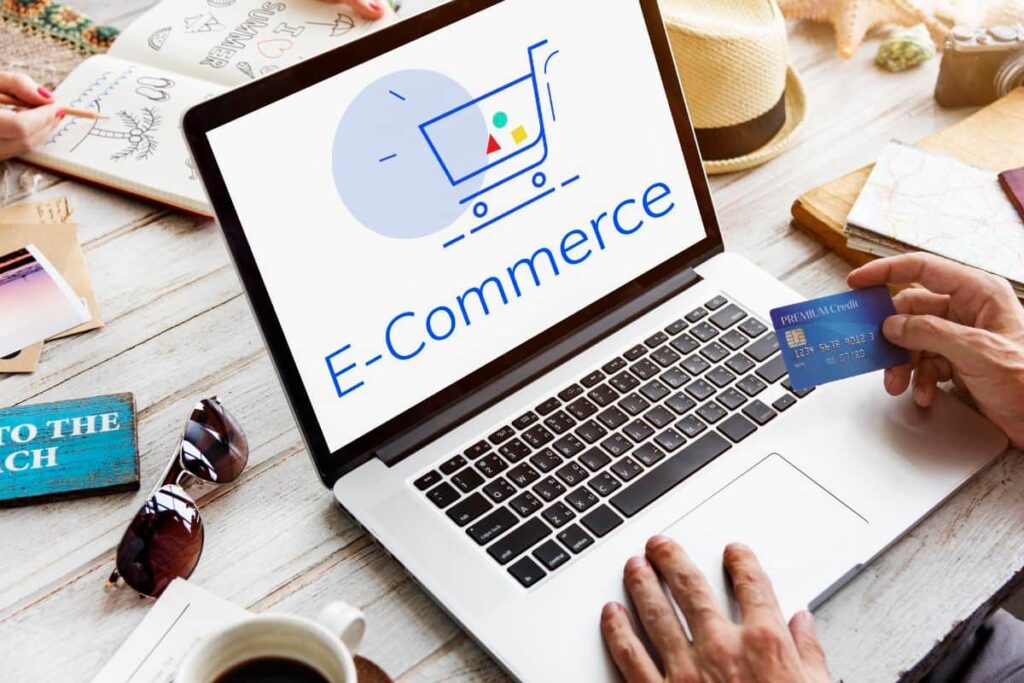E-commerce enablement has become a crucial tactic for companies hoping to succeed in the cutthroat market in the quick-paced digital age. The term refers to the process of equipping companies with the tools, technologies, and infrastructure needed to establish and optimize their online presence. This transformation enables organizations to connect with a broader audience, streamline operations, and enhance the overall customer experience.
What is E-commerce Enablement?
E-commerce enablement refers to the process of empowering and facilitating businesses to conduct electronic commerce, commonly known as e-commerce. It involves providing the necessary tools, technologies, and support systems to help companies establish and enhance their online presence, conduct transactions, and manage various aspects of their digital storefronts.
Critical Components of E-commerce Enablement
Website Development
Website development serves as the foundational pillar in establishing an online store. It involves the comprehensive process of creating a digital space meticulously designed to offer an intuitive and user-friendly interface. This method prioritizes ease of discovery and attempts to give clients a smooth and delightful experience. The emphasis on aesthetics and functionality ensures that visitors can effortlessly explore the online store, fostering positive interactions. The ultimate goal is not just to showcase products or services effectively but to create a digital environment that reflects the brand identity and resonates with the target audience.
Payment Gateway Integration
Facilitating secure online transactions is a critical aspect of E-commerce Enablement, and payment gateway integration is vital to achieving this. Payment gateways act as intermediaries, allowing customers to make secure online payments. The integration process involves incorporating various payment options, such as credit cards, digital wallets, and other online payment methods, into the online store’s checkout process. This flexibility not only caters to diverse customer preferences but also ensures the highest standards of security. Customer confidence and trust are built through the smooth integration of payment systems, which eventually boosts sales and improves customer satisfaction.
Inventory Management
Efficient management of products or services forms the backbone of a successful e-commerce business. Inventory management is a meticulous process involving real-time tracking of stock levels, automated updates of product availability, and the implementation of processes to prevent issues like overselling or stockouts. The primary objective is to streamline operations, minimize manual errors, and optimize resource utilization. Implementing effective inventory management systems enhances overall efficiency, reduces costs, and provides a reliable and satisfying shopping experience for customers.
Customer Relationship Management (CRM) Systems
CRM solutions are essential for tracking and evaluating consumer interactions during the customer lifecycle. These systems come with features for keeping tabs on past purchases, customizing services, and monitoring client preferences. By customizing interactions to meet individual needs, the ultimate goal is to increase customer happiness and loyalty. E-commerce Enablement companies can create more profound and more lasting connections with their clientele by employing CRM systems.
Logistics and Fulfillment
The logistics and fulfillment component involves the strategic planning and execution of product delivery. It encompasses order processing, shipping, and tracking. Integration with logistics partners and the implementation of efficient fulfillment processes ensure timely and accurate delivery to customers. This streamlined approach to logistics not only improves the client experience in general but also contributes to the reputation and reliability of the E-commerce Enablement business.
Security Measures
Security is paramount in the realm of E-commerce Enablement. The implementation of robust security findings is essential for protecting sensitive customer information, including personal details and payment data. It involves incorporating encryption, secure socket layer (SSL) certificates, and adherence to industry standards. By prioritizing security, e-commerce businesses build trust with their customers and safeguard against potential threats, fostering a secure online shopping environment.
Analytics and Reporting
Gathering and analyzing data play a pivotal role in making informed business decisions within the e-commerce landscape. Analytics tools give valuable insights into customer behavior, sales trends, and website performance. Reporting functionalities enable businesses to monitor key metrics and adapt strategies for continuous improvement. By employing data-driven insights, E-commerce Enablement companies may fine-tune their approach, improve user experience, and achieve better results in the increasingly competitive online industry.
Choosing the Right E-commerce Platform
Factors to Consider
- Scalability Scalability refers to the platform’s ability to grow with your business. Consider the potential for expansion and whether the platform can accommodate increased traffic, products, and transactions over time.
- Customization Options Evaluate the degree of personalization that the platform offers.
- It includes the ability to tailor the look and feel of your online store, integrate unique features, and adapt functionalities to match your brand’s identity.
- Integration Capabilities For smooth operations, integration with other tools and services is essential. Check whether the e-commerce platform supports critical integrations such as payment gateways, inventory management systems, and marketing tools.
Popular E-commerce Platforms
Shopify
Shopify is user-friendly. It is a fully hosted e-commerce platform. It’s known for its simplicity and offers a range of customizable templates. Shopify is a good choice for businesses looking for a quick setup and an intuitive interface. It also provides a variety of apps for extending functionality.
WooCommerce
WooCommerce is a WordPress plugin. It turns your WordPress website into an online store that is ready to go live. It’s highly configurable, making it ideal for organizations that already have a WordPress website. WooCommerce provides flexibility and scalability by allowing users to install all types of plugins and themes.
Magento
Magento is an open-source e-commerce platform with robust features, making it suitable for larger enterprises. It provides a high level of customization and scalability but may have a steeper learning curve. Businesses requiring a great deal of customization and sophisticated requirements may consider Magento.
E-commerce Enablement Strategies
- Establishing a presence across various online channels, such as a company website, social media platforms, and third-party marketplaces.
- Ensuring that the mobile-friendly E-commerce Enablement platform offers a smooth and intuitive experience on tablets and smartphones.
- Implementing personalized experiences for users based on their preferences, behavior, and past interactions with the platform.
- Incorporating e-commerce features straight into social media networks to enable product browsing and purchases without ever leaving the network.
- Concentrating on streamlining navigation, improving the whole online buying experience, and developing an intuitive and user-friendly interface.
- Leveraging analytics tools to gather and analyze data related to customer behavior, preferences, and website performance.
- Provide all types of secure payment methods and integrate reliable payment gateways to ensure the safety of customer financial transactions.
- Integrating e-commerce systems with supply chain and inventory management to optimize order fulfillment and maintain accurate stock levels.
- Distributing and Creating valuable and relevant content, such as product descriptions, blog posts, and videos, to attract and engage customers.
- Putting in place efficient customer service channels and communication plans, such as social media, email, and live chat, to quickly respond to questions and issues from customers.
- Consistently update and enhance the E-commerce Enablement platform in response to user input, technology developments, and market trends.
- Ensure that E-commerce Enablement operations adhere to applicable rules and regulations, including data protection and consumer rights.
Benefits of E-commerce Enablement
Global Reach
E-commerce allows firms to offer their products or services to consumers all over the world, removing the constraints of physical places. It means that companies are open to serving more than just local customers but can tap into a diverse, global audience.
Example: A small boutique in Paris can sell its unique fashion items to customers in the United States, Asia, or any other part of the world through its online store.
24/7 Accessibility
E-commerce allows businesses to be operational at all hours of the day, every day of the week. Customers can browse, make purchases, and access services whenever it suits them, regardless of traditional business hours. This accessibility is particularly valuable for reaching customers in different time zones.
Example: An online electronics store allows customers to shop for gadgets or place orders for tech support at any time, accommodating various schedules and time zone differences.
Cost Efficiency
E-commerce can be more cost-effective compared to traditional retail models. Businesses save on expenses related to physical storefronts, such as rent, utilities, and the need for in-store staffing. This cost efficiency is especially advantageous for smaller businesses with limited resources.
Example: A startup selling handmade crafts can avoid the values associated with maintaining a physical store and instead reach a broad audience by selling its products exclusively on an E-commerce Enablement platform.
Data-driven Decision Making
E-commerce platforms come with tools that collect and analyze data on customer behavior, preferences, and buying habits. This data gives valuable insights that businesses can use to make informed decisions. For example, understanding what products are popular, when customers are most active, or how they navigate the website can help businesses optimize their strategies.
Example: An online bookstore analyzes data to identify the genres most frequently purchased by its customers, enabling it to tailor its inventory and promotions to meet customer preferences better.
Enhanced Customer Experience
E-commerce enablement allows businesses to create a more personalized and enjoyable experience for customers. Features like customized product recommendations, user-friendly website interfaces, and convenient payment options contribute to a positive and engaging online shopping experience. It, in turn, fosters customer satisfaction and loyalty.
Example: An online clothing store offers personalized style suggestions based on a customer’s past purchases, making the shopping experience more enjoyable and tailored to individual preferences.
Scalability
E-commerce Enablement platforms are designed to grow with a business. They can easily handle increased website traffic, a broader range of products, or higher numbers of customer transactions. This scalability allows companies to expand and adapt their online presence efficiently as demand grows.
Example: A small artisanal coffee company starts with a limited product range, but as it gains popularity, the e-commerce platform easily accommodates the addition of new coffee blends, merchandise, and an increased number of transactions.
Overcoming Challenges in E-commerce Enablement
Security Concerns
E-commerce transactions involve sensitive customer data, making security a top concern. For internet organizations, the possibility of fraud, hacking, and data breaches presents a severe problem.
Solution
- Implement robust cybersecurity measures, including encryption protocols, secure payment gateways, and regular security audits.
- Regularly update and patch systems to protect against emerging threats.
- Educate customers about safe online practices to minimize vulnerabilities.
Logistics and Supply Chain Management
Timely product delivery requires efficient logistics and supply chain management. Inventory management, order fulfillment, and return handling are all complex tasks.
Solution
- Utilize AI and analytics for demand forecasting to optimize inventory levels.
- Implement an efficient order fulfillment system and establish partnerships with reliable logistics providers.
- Streamline the returns process to enhance customer satisfaction.
User Experience and Personalization
It cannot be easy to deliver a smooth and customized user experience because of the wide range of client preferences and the requirement for real-time customizing.
Solution
- Leverage AI algorithms for personalized product recommendations, targeted marketing, and dynamic content.
- Invest in user-friendly website design, intuitive navigation, and responsive customer support.
- Regularly gather and analyze customer feedback to make continuous improvements.
Cross-Border E-commerce Challenges
Expanding worldly involves dealing with different regulations, currencies, and cultural nuances. Cross-border e-commerce introduces complexities in terms of shipping, taxes, and compliance.

Solution
- Research and comply with regulations in target markets.
- Partner with international logistics providers to streamline shipping processes.
- Offer multiple currency options and clearly communicate shipping costs and import duties.
- Adapt marketing strategies to resonate with diverse cultural backgrounds.
Technology Integration and Scalability
E-commerce platforms must be adaptable to technological advancements and scalable to handle increasing traffic and transactions.
Solution
- Invest in a flexible and scalable e-commerce platform that can evolve with technological changes.
- Regularly update software and infrastructure to stay current with industry standards.
- To make sure the platform can withstand periods of high demand, test load on it.
Essential Tools and Software for Ecommerce Operations
Shopify, WooCommerce, Magento
These are popular e-commerce platforms that assist in creating and handling online stores. They offer features such as product listing, inventory management, and order processing. Users can customize and design their online stores, making them visually appealing and functional.
Stripe, PayPal, Square
These tools are designed to ensure secure online transactions. They integrate seamlessly with e-commerce platforms, enabling businesses to process payments and manage financial transactions securely. Consumers may shop with assurance as they know that their credit card information is protected.
HubSpot, Salesforce, Zoho CRM
Customer Relationship Management tools are essential for managing customer relationships. They aid in tracking customer interactions, managing leads, and enhancing overall customer satisfaction. Integration with E-commerce Enablement platforms allows businesses to streamline and centralize customer data for more effective marketing and customer service.
TradeGecko, DEAR Inventory, Skubana
Inventory management tools are crucial for tracking and handling product stock levels. They ensure that products are adequately readily stocked and available for customers. Integration with E-commerce Enablement platforms helps in maintaining accurate inventory data and preventing issues like overselling or stockouts.
ShipStation, ShipWorks, Shippo
These tools automate the shipping process for online businesses. They generate shipping labels and provide real-time tracking information to both businesses and customers. Integration with many shipping providers enables enterprises to select the most economical and practical shipping solutions.
Google Analytics, Mixpanel, Kissmetrics
Analytics technologies are essential for comprehending website performance and customer behavior. They track website traffic, user interactions, and other metrics to provide insights into how customers engage with the site. Businesses can use this data to optimize their websites, marketing strategies, and overall user experience.
Mailchimp, Klaviyo, Omnisend
Marketing automation tools assist businesses in creating and managing targeted email campaigns. They automate the process of sending emails based on customer behavior, preferences, and other criteria. These tools enhance overall marketing efforts by providing personalized communication to customers and improving engagement and conversion rates.
Zendesk, Freshdesk, Gorgias
Customer support tools are designed to streamline and enhance communication with customers. They offer various channels for customer interaction, including live chat, email, and social media. Businesses can efficiently manage customer inquiries, resolve issues, and provide excellent customer support.
SSL Certificates, McAfee SECURE, TrustArc
Security tools are necessary to guarantee both regulatory compliance and the safety of client data. By encrypting data transferred between a website and its visitors, SSL certificates improve security. By displaying trust badges and certifications, McAfee SECURE and TrustArc assist organizations in demonstrating their dedication to security and cultivating client trust.
WordPress, Drupal, Joomla
These are platforms for content management systems (CMS), which are essential for producing and overseeing website content. They offer an intuitive user interface for creating and editing web pages, which simplifies the process of managing product descriptions, blog entries, and other types of informative content. Without requiring a great deal of technical understanding, users may quickly generate, update, and arrange content, which makes managing website content more compelling.
Hootsuite, Buffer, Sprout Social
eCommerce companies need to be active on social media to engage with their customers. With the help of these technologies, social media postings can be scheduled for a variety of platforms, guaranteeing timely and reliable content delivery. Additionally, they assist in monitoring interaction data and offer statistics to evaluate the effectiveness of social media initiatives, enabling companies to improve their approaches.
Backblaze, Acronis, CodeGuard
Regularly backing up data is crucial to prevent data loss due to various hardware failures, human errors, or cyber threats. These tools automate the backup process, regularly saving copies of website data and content. In case of data loss or corruption, these tools facilitate quick and efficient data recovery, ensuring that businesses can restore their websites to their previous state.
Future Trends and Predictions in E-commerce Enablement
Increased Emphasis on Augmented Reality (AR) and Virtual Reality (VR)
E-commerce is expected to leverage AR and VR technologies to enhance the online shopping experience. It could include virtual try-on features for clothing and accessories, augmented reality previews for furniture in your home, or virtual showrooms for various products. The goal of these technologies is to close the gap between online and offline shopping.
Rise of Voice Commerce
Voice commerce is anticipated to increase in prevalence as virtual assistants and smart speakers gain in popularity. Consumers may use voice commands to search for products, place orders, and receive personalized recommendations. E-commerce platforms are likely to integrate with voice-activated devices to streamline the shopping process.
Increased Personalization through AI
The personalization of the online purchasing experience will remain largely dependent on artificial intelligence (AI) and machine learning algorithms. E-commerce platforms will use customer data to provide more tailored product recommendations, personalized marketing messages, and a more individualized overall shopping journey. It can enhance customer satisfaction and increase conversion rates.
Expansion of Social Commerce
Social media sites are starting to take on essential roles in the e-commerce industry. The integration of shopping features directly into social media platforms allows users to discover and purchase products without leaving the app. This trend is likely to grow, with social commerce becoming a key channel for online sales. Social media platforms are expected to invest more in e-commerce functionalities, blurring the lines between social networking and online shopping.
E-commerce Enablement for Small Businesses
Budget-friendly Solutions
Small businesses often operate with limited budgets, so it’s crucial to find cost-effective solutions for e-commerce enablement. It can include using budget-friendly tools and platforms to establish and manage online stores.
Examples
- Open-source E-commerce Platforms Platforms like WooCommerce and Magento are open-source and offer robust e-commerce features without hefty licensing fees.
- DIY Website Builders: Services like Shopify, Wix, or Squarespace allow businesses to create their professional-looking websites without the need for extensive technical expertise.
- Marketing Strategies for Small Businesses
Tiny businesses need to utilize innovative marketing to draw in clients. Due to financial limitations, it is crucial to concentrate on tactics that have the most significant impact at the lowest cost.
Examples
- Social Media: Marketing on a Budget Utilizing free or low-cost social media platforms for marketing and engagement.
- Collaborative Partnerships: Forming partnerships with complementary businesses for joint marketing efforts, reducing individual costs.
Building Customer Trust
Establishing trust is vital for small businesses entering the online marketplace. Trustworthy practices contribute to customer confidence and loyalty.
Examples
- Transparency in Transactions: Clearly communicating pricing, shipping costs, and return policies to build transparency and trust with customers.
- Customer Reviews and Testimonials: Encouraging and showcasing positive customer reviews and testimonials to build credibility.
The Role of AI in E-commerce Enablement
Personalization
Personalization in e-commerce involves using AI algorithms to analyze customer data such as purchases, browsing history, preferences, and behavior. The goal is to provide tailored recommendations to customers, enhancing their shopping experience. By understanding individual preferences, AI algorithms suggest products that align with a customer’s interests, increasing the chances of successful purchases.
Search and Discovery
AI-powered search engines Make use of natural language machine learning and processing to understand user queries better and deliver more accurate search results. The aim is to help users find products quickly and easily, improving the overall navigation experience on e-commerce platforms. AI algorithms interpret user queries, enabling more relevant search results and making the product discovery process more efficient.
Chatbots and Virtual Assistants
AI-driven chatbots provide instant customer support, answer queries, assist with product selection, and guide customers through the purchase process. Virtual assistants enhance overall customer service. To provide immediate and efficient customer support, improving the overall customer experience. Chatbots use AI algorithms to understand and answer customer queries, providing real-time assistance. Virtual assistants extend this support across various customer service interactions.
Supply Chain Optimization
AI helps optimize inventory management, demand forecasting, and supply chain logistics for e-commerce businesses. Help keep stocks at ideal levels, cut expenses, and improve supply chain performance. AI algorithms analyze data to predict demand, manage inventory effectively, and streamline logistics, ensuring a well-optimized and cost-effective supply chain.
Fraud Detection and Security
AI algorithms analyze transaction patterns to detect anomalies and prevent fraudulent activities in online transactions. To increase client trust and improve the security of online transactions. The overall security of E-commerce Artificial intelligence (AI) enhances transaction enablement by continuously monitoring and analyzing transaction data for unusual patterns or behaviors that may indicate fraud.
Dynamic Pricing
AI enables dynamic pricing strategies, allowing E-commerce Enablement enterprises to modify rates in real-time based on demand, competition, and customer behavior. The goal is to maximize revenue and competitiveness by setting prices that align with market conditions. AI algorithms analyze all types of data points, such as demand fluctuations and competitor pricing, to automatically adjust prices, ensuring they remain optimal and responsive to market dynamics.
Customer Insights
AI analyzes vast amounts of data to derive essential insights about consumer trends, behavior, and preferences. E-commerce Enablement businesses use these insights to make informed decisions, tailor marketing strategies, and optimize their product offerings to meet customer expectations better. AI algorithms analyze customer data, identifying patterns and trends that provide valuable information for businesses to understand and respond to customer needs effectively.
Augmented Reality (AR) and Virtual Try-Ons
AI-powered AR applications enable virtual try-ons, allowing customers to visualize products in real-world settings before making a purchase decision. It enhances the online shopping experience, particularly for items like clothing, furniture, or home decor, by giving customers a more realistic and engaging preview of products. AI algorithms integrate with AR technology to enable virtual try-ons, overlaying digital representations of products onto the real-world environment through the user’s device, such as a smartphone or tablet.
Voice Commerce
AI-driven voice recognition technology facilitates voice-activated searches and purchases, providing users with a hands-free and convenient shopping experience. It offers a more accessible and seamless shopping experience, especially for users who prefer using voice commands. AI algorithms enable voice recognition, allowing users to interact with E-commerce Enablement platforms to search for products verbally, Add items to the cart, and fully purchase. It provides a convenient alternative to traditional browsing and clicking.
Conclusion
In conclusion, e-commerce enablement is not only a trend but a requirement for businesses looking to thrive in today’s digital economy. By embracing e-commerce enablement strategies, companies can stay ahead of the competition, reach a wider audience, and provide exceptional online shopping experiences for their customers. As consumer behaviors continue to shift towards digital channels, e-commerce enablement will remain a key driver of business success in the years to come.
Frequently Asked Questions (FAQs)
What is e-commerce enablement, and why is it essential for businesses?
E-commerce enablement refers to the process of leveraging technology and tools to facilitate online transactions and improve overall online business operations. It is crucial for businesses as it expands their reach, enhances customer experience, and increases efficiency in managing online sales, ultimately driving growth.
What key features should I look for in an e-commerce enablement platform?
When choosing an e-commerce enablement platform, consider features such as user-friendly interfaces, secure payment gateways, mobile responsiveness, inventory management, seamless integration with other business systems, and robust analytics for insights into customer behavior and sales performance.
How can companies in e-commerce enablement guarantee the safety of client transactions?
Security is paramount in E-commerce Enablement. Implement secure sockets layer (SSL) certificates for encrypted data transmission, use reliable payment gateways, comply with industry standards for data protection, regularly update software for vulnerabilities, and educate customers on safe online practices to build trust and safeguard transactions.
What role does mobile optimization play in e-commerce enablement?
Mobile optimization is crucial as a growing number of consumers use smartphones for online shopping. Ensure your E-commerce Enablement platform is responsive and provides a seamless mobile experience. It includes easy navigation, quick load times, and mobile-friendly payment options to cater to mobile users’ preferences.
How can businesses leverage data analytics in e-commerce enablement?
Data analytics is instrumental in understanding customer behavior, improving marketing strategies, and optimizing operations. Make use of analytics tools to gather insights on customer preferences, track website traffic, and analyze sales patterns. Make informed decisions to enhance the overall E-commerce Enablement experience and drive business success.



































